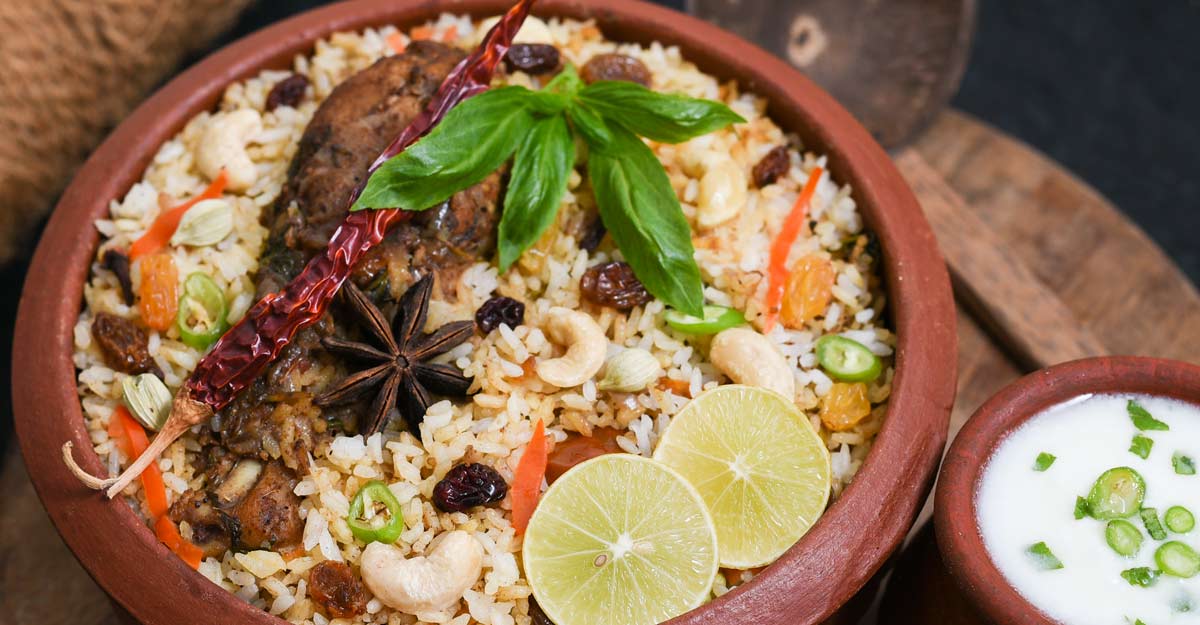The different biryanis of India

Every state and locality of India prides itself on its own unique biryani recipe.
Every state and locality of India prides itself on its own unique biryani recipe.
Every state and locality of India prides itself on its own unique biryani recipe.
Biryani, the food of the Gods is more than just a rice and meat dish. It is one of the most loved wholesome dishes in India that absolutely cannot be missed by locals and tourists alike.
Origin and history
There are several theories that attempt to trace the origin of biryani - Biryani was said to be first cooked in India under the reign of Shahjahan and Mumtaz Mahal. Mumtaz Mahal who was an inspiration for many during her time, had visited an army camp and had seen that the soldiers were lacking nutrition in their daily diet. Upon which, she instructed the cooks to prepare a nutritive and lavish meal. And so, to cater to an entire army, rice was cooked along with meat, to not only be filling but also provide the required nutrition and that is how biryani was born.
Every state and locality of India prides itself on its own unique biryani recipe. While we cannot delve deep into each and every type of biryani across the country, below are some of the more famous ones we think you should familiarise yourselves with. How many of these biryanis do you know of and have tried?
Lucknowi or Awadhi Biryani

The King of all biryanis, the Awadhi biryani was made by the Mughal Khansamahs in Awadh in the 18th century. The Awadhi biryani is cooked in the Dum method where by the meat is marinated with spices and is partially cooked, separately from the rice, which is flavoured with saffron, cinnamon and star anise. The meat and rice are then added together in a Handi in separate layers and cooked over a low flame for hours until the flavours seep in through the meat, making it uber soft, succulent and flavoursome.
Kolkata Biryani
This Awadhi biryani style came to Kolkata along with Nawab Wajid Ali Shah (ruler of Awadh) when he was deported and asked to take over the reins of Bengal by the British Raj. This Awadhi biryani developed into an altered form in Kolkata, which included the addition of deep-fried potatoes by the masses to replace meat - which was a relatively expensive food item. Nowadays the Kolkata biryani is cooked using nutmeg, saffron, cinnamon, mace, cloves, cardamom, soft boiled eggs, yoghurt marinated meat and of course fried potato. A special ingredient - rose water gets sprinkled on top of the biryani that lends an incredibly unique and memorable flavour to this biryani.
Degh Ki Biryani
Degh ki Biryani is famous in the city of Parbhani in Maharashtra which is ironically also known as the ‘Land of Saints’. This biryani is typically made using small cubes of either beef or mutton. It requires the meat to be marinated with a concoction of ginger, garlic, red chilli powder, cumin powder, garam masala, yoghurt and fried onions. Degh Biryani gets its name from the vessel in which it is cooked using the dum method, that is the Deghchi. This biryani is also famously known as Kacche Gosht Ki Biryani and is traditionally served in marriages across the country.
Memoni Biryani
Memoni Biryani or Kutchi Biryani, derived from Pakistan Sindh Biryani, is one of the spiciest varieties of Biryani in India. It comes from the Muslim dominated, Gujarat-Sindh region of the country. Gujarat is known to be a vegetarian state, and it is a little known fact that 40% of the state’s population are meat-eaters. The biryani was introduced by the Memons, an ethnic trading community of this region who migrated to Kutch in Gujarat, from Sindh in 1422. The biryani is made with a unique combination of lamb, yoghurt, fried onions, potatoes, tomatoes and dried plums. As is with all biryanis - soft meat forms the base of the dish. Natural food colour reigns supreme and food colourings are used sparingly in this Biryani.
Ambur biryani
Originating from Ambur in Tamil Nadu, the Ambur biryani was introduced by the Nawabs of Arcot who ruled the area from 1710-1768. The Ambur biryani is usually made from either basmati or short-grained Seeraga Samba rice. The speciality of this biryani is its strong meaty flavour. The meat is soaked in yoghurt and then flavoured with mint and coriander before adding to the cooked rice along with other whole spices. This biryani is similar to the Lucknowi Biryani but is considered to be lighter on the stomach than the former. Ambur biryani is traditionally accompanied by dalcha - a sour brinjal curry and pachadi – yoghurt mixed with onions, tomatoes, chillies and salt.
Hyderabadi Biryani
One of the most popular and flavourful Biryanis of India, the Hyderabadi biryani came into existence in the late 1600s, after Aurangzeb invaded Hyderabad and appointed Niaz-Ul-Mulk as the new ruler of Hyderabad. In his desire to show gratitude to Aurangzeb, Niaz-Ul-Mulk ordered his cooks to create several new dishes for a grand feast. The appointed chefs reportedly created over 50 different versions of flavoured rice using fish, shrimp, quail, deer and hare meat – and thus the Hyderabadi Biryani was born. The traditional Hyderabadi Biryani today, is made using raw goat meat that is marinated and cooked for hours together with saffron flavoured rice until the meat’s flavours permeate into every grain of rice. Fried onions, also known as Birista, mint and coriander leaves and spices are added to the Biryani, to add a rich and wholesome flavour.
Kalyani Biryani
Kalyani Biryani or the ‘poor man’s’ Hyderabadi biryani was introduced by the Kalyani nawabs of Bidar who came to Hyderabad in the 18th century. The Kalyani biryani is typically made with small cubes of beef, spices, onions, tomatoes and coriander. The meat is marinated with ginger, garlic, turmeric, red chillies, cumin, coriander powder and then cooked in a tomato and onion gravy before cooking together with the rice. Because of the use of beef in the biryani, the Kalyani biryani is also commonly known as beef biryani.
Thalassery Biryani
Thalassery biryani was introduced in the Malabar region by the Arab traders who came to trade in Calicut from the 9th to the 16th century. The biryani, influenced by the Arab style of cooking, is a sweet and spicy version of biryani and is most commonly found in this region of Kerala. It is made with a special type of rice called Khyma or Jeerakasala rice (short-grained rice) instead of basmati. The rice is mixed with ghee and is fried and cooked separately from the gravy and then mixed together and cooked. Other key ingredients used are meat, fried onions, fennel seeds, Malabar spices, ginger garlic paste, yoghurt, mint and coriander leaves. The biryani is garnished with sautéed cashew nuts and sultana raisins that give the biryani its sweet taste.
Kashmiri or Tahari Biryani
The Kashmiri biryani, also known as Tahari biryani was first brought into existence by the Kashmiri Pandits or the Hindu bookkeepers of the Muslim Nawabs. It was prepared by adding potatoes to the rice in place of meat and is thus a purely vegetarian biryani. The Tahari Biryani today, is made using a lot of vegetables but without any onion or garlic. Hing or asafoetida is used as a substitute for onion and garlic in this biryani. Fennel powder, dry ginger powder and garam masala add to the flavour and aroma of this delectable dish. Like the Thalassery biryani, the Tahari biryani too is garnished with fried or sautéed cashews and raisins that lend a sweet flavour to this unique Biryani. The Tahari biryani is a befitting answer to all those who swear on the fact that biryani is delicious only when made with meat.
We hope that this article has got your mouth watering! It sure has got ours! So why wait?
Let’s try our hand at cooking some of these wonderful biryanis and pamper ourselves to the food of the Gods!

